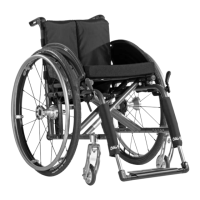60
When descending slopes, do not drive without braking and
reduce your speed.
Extreme settings (e.g. rear wheels mounted in
the foremost position) combined with an unfavourable body posture can cause the wheelchair to tip
even on level ground. Avoid extreme settings. For transfemoral amputees it is essential to shift the rear
wheels backwards. Use of an anti-tipper is required.
Under no conditions should
the anti-tipper assume the function of transport wheels, for example to transport a person in the wheel-
chair with the rear wheels removed. The anti-tipper must audibly lock in place, before it is able to bear
loads. Firm seating must be veried by the user or by an attendant.
If the size
and position of the casters or the rear wheel size are modied, the casters may utter when driving at
higher speeds. This can lead to blocking of the casters and cause the wheelchair to tip over. For this
reason, you should always maintain the factory settings or, if modications are required, ensure that
the wheelchair frame is aligned horizontally (see “Adjustment / Assembly Instructions”).
Always make sure that the
quick-release axles are correctly set on the rear wheel. The rear wheel must not be removable without
the button of the quick-release axle being depressed.
The effectiveness of the
wheel lock and the overall driving quality are dependent on adequate air pressure. The wheel locks
are only effective with sufcient air pressure and proper adjustment (approx. distance, subject
to technical changes).
Before starting to use your wheelchair, check that the tyres are inated correctly. The required air
pressure is printed on the side of the tyre. For rear wheels, it should be . With properly
inated rear wheels and even tyre pressure on both sides, your wheelchair is much easier to operate
and manoeuvre.
Insufcient tread depth of the tyres reduces adhesion.
Please note that when you operate your wheelchair in public road trafc, you are subject to road traf-
c regulations.

